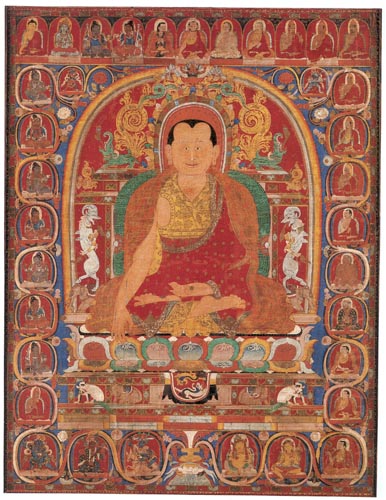| 30. Portrait of an Abbot
|

30.
Portrait of an Abbot
Central Tibet (a Kogyu monastery), ca.
1350
Distemper on cloth
77 x 59.7 cm (303/8x 231/2 in.)
The Metropolitan Museum of Art, New York, Purchase,
Miriam
and Ira D.
Wallach Philanthropic Fund Gift, 1991 (1991.304)
|
This painting exhibits an eclectic blend of Nepalese and eastern Indian styles as well as other features that point to
a mid-fourteenth-century date. The abbot is shown in bhumisparsha mudra (the earthtouching gesture); he sits
on a lotus that rests on a throne base inhabited by lions and elephants. These are not the truncated animals of the
earlier paintings, with just heads and front feet or paws showing, but rather the entire creature is seen in a profile
portrayal. The lions sit up on their haunches, heads turned inward; their heads and tails overlap the upper and lower
horizontal moldings of the throne base. A throne cloth emblazoned with lions chasing each other's tails falls over
the center of the base, backed by a yellow frame rather than the traditional void. The hierarch is attired in a
particularly splendid gold-patterned mantle, and even his red undergarment, usually undecorated, is adorned with a
pattern of small rosettes and a narrow gold border. The
same ornamental tendency can be seen in the outline of the mantle. Fabric surrounds the severe profile of the
knees in undulating folds, softening the form, and lappets of cloth fall over the
legs.1 These stylized but observed
details herald the more naturalistic treatment of attire that is seen in the mature Tibetan style of the mid-fifteenth
century. The form of the throne back is typical of the
eastern Indian style, with the addition of the small kinnaras perched on the ends of the lower bar, but the
torana is Nepalese in format, with a squatting Garuda at the top flanked by nagarajas, snakes, and addorsed
makaras with foliate tails. Also unusual is the form of the scrolling vegetation
around the nimbus, absent in the Nepalese-style thankas but appearing here in the form of small tufts of foliage
interspersed with lotus buds. The whole ensemble is surrounded by a rainbow.
At the center of the bottom register is a small pool. In its midst is a vishvavajra with a lotus flower
emerging
from the center. The lotus is a symbol of transcendent purity and, as the sacred navel from which the imagery
springs, the vishvavajras reinforce this. On this lotus is set a water pot
(ghara) encircled by ribbons tied into bows at
its sides (see cat. no.17). From the pot comes yet another lotus plant, scrolling about the figures of deities and
religious progenitors that fan out to the left and right and along the sides of the painting. A central stalk supports
the throne base and is theoretically the source of the lama's lotus seat. The scrolls on the left side of the
painting are occupied by a series of mahasiddhas, on the right by a lineage of abbots, and beneath by protective
deities (from left to right): Mahakala, Gurgonpo Lhamo, Kubera, Tara, and a monk. The top register shows a Kagyu lineage with Phakmo Drupa at the center and featuring
many of the well-known progenitors of the sect (see cat. no. 17). This inhabited-scroll motif has its roots in Indian
art and appears in Tibet as early as the late twelfth century (see cat. no. 22).
SMY
1. A more exaggerated version can be seen in several
late-fourteenth-century portraits from Taklung monastery; see Singer 1997, pls. 44, 48, 49.
[back]
|
